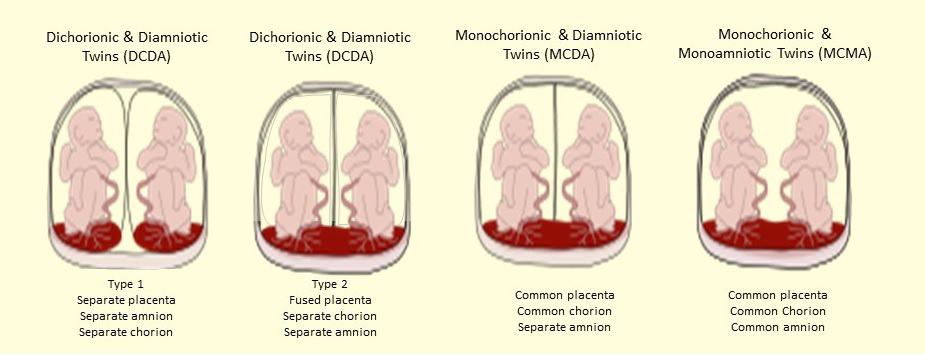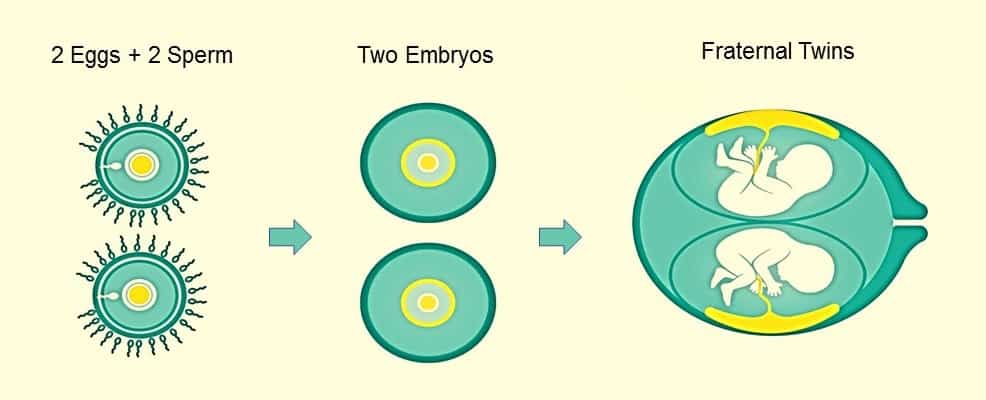Types of Twins
Identical Twins, Fraternal Twins and more…
Medically Reviewed by: Dr. Veena Shinde (M.D, D.G.O, PG – Assisted Reproductive Technology (ART) from Warick, UK) Mumbai, India
-
Author: Palak Thakkar
- >> Post Created: August 19, 2020
- >> Last Updated: May 2, 2024

Types of Twins - Table of Contents
When I was pregnant with triplets I was curious to know the science behind it as none in my family ever had multiples. I started reading books, did my research on the internet, went through some white papers, and also spoke to mothers who have been through similar experience. This not only gave me confidence but also improved my understanding on different topics such as types of twins, gestation for twins, unusual events of twin pregnancy and much more.
Multiple births are more common than they were in the past, due to the advancing average age of mothers and the associated rise in assisted reproductive techniques, in particular the use of fertility drugs. 90% of the multiple births around the world are twins.
There are two primary types of twins—identical twins (monozygotic) and fraternal twins (dizygotic), while the third type is still being studied.
Through this article, I will try and cover as much as possible about different Types of Twins and a few other topics related to twin pregnancy.
Factors that increase the odds of having twins
We have seen women being fascinated with the notion of having twins and many women have asked us how did we have multiples? Well some women are more likely than others to give birth to twins. The factors that increase the odds include:
- Advancing age of the mother—The levels of sex hormones—estrogen—is higher in women in their 30s and 40s than younger women. It means that their ovaries could release more than 1 egg at a time. This forms an important part while considering conception of twins.
- Previous pregnancies—The greater the number of pregnancies a woman has already had, the higher her odds are of conceiving twins.
- Heredity—inherit clear skin, while others inherit strong thick hair, but some other women inherit the likelihood of having multiple babies. The chances of a woman conceiving twins is higher if she herself is a twin, and if a woman has previously given birth to twins then again the chances increase of her becoming pregnant with twins. If the woman has siblings who are twins then also her chances are higher of conceiving twins. Sometimes this kind of thing runs in the family through generations.
- Assisted reproductive procedures—Many of these techniques rely on stimulating the ovaries with the help of fertility drugs to produce eggs, which results in multiple eggs being released per ovulation. Other than fertility drugs, other techniques like IVF, artificial insemination, etc. also have a higher chance of conceiving multiples.
How does a woman get pregnant with twins — Fertilization
The pituitary gland situated in our brain controls our menstrual cycle. A women’s average monthly cycle is of 28 Days.
After every menstrual cycle, the estrogen levels rise. This helps to thicken the lining of the womb (the endometrium) and the release of one egg from the ovaries (ovulation).
Then the egg gets fertilized and settles on the thick womb lining and divides and evolves into an embryo.
The entire fertilization process is the same for conceiving twins, slight differences decides types of twins – whether fraternal or identical is explained in the sections below.
Different Types of Twins
Identical Twins or Monozygotic Twins

When it comes to different types of twins, approximately one out of every 3 sets of twins are Identical Twins.
Twins that are conceived from one egg and one sperm are called identical twins or ‘MONOZYGOTIC Twins’ (One-cell twins). How does a single fertilized egg split into two is still a biological mystery.
Process of fertilization of Identical Twins:
In Identical types of Twins, 1 fertilized egg divides into 2 while staying in a tiny collection of cells. These self-contained halves slowly develop into two babies.
These babies have the exact same genetic formation—SAME DNA.
Common Types of Identical Twins

Within identical types of twins there are different categories, and these categories depends upon what they share in the womb.
- Dichorionic Diamniotic Twins (DI DI twins): DI DI Twins are found in about one in every three identical twins. DI DI twins have separate placenta, separate inner membrane (amnion), and separate outer membrane (chorion) for each baby. The medical or official term for such types of twins is ‘Dichorionic Diamniotic Twins’ or more regularly known as the DI DI Twins.
- In another type of the DI DI Twins, it is found that these DI DI twins have a fused placenta but separate inner membrane (amnion) and separate outer membrane (chorion).
- Monochorionic Diamniotic Twins (MO DI twins/ MONO DI Twins): MO DI twins/MONO DI twins are the most commonly found types of twins. Almost two-thirds of identical twins – the MO DI twins/ MONO DI Twins – share the same placenta and chorion, but have their own amnion. These are ‘Monochorionic Diamniotic Twins’ and are commonly referred to as MO DI twins/ MONO DI Twins.
- Monochorionic Monoamniotic Twins (MO MO twins): The rest—only about 4% of identical twins also known as the MO MO twins — share everything. These types of twins are scientifically called ‘Monochorionic Monoamniotic Twins’ or the MO MO Twins.
Even though identical twins will have the same sex and will be genetically identical, their personalities may be different.
If you are pregnant with twins or more, the principles are similar.
Fraternal Twins or Dizygotic Twins

When we consider type of twins, every 2 out of 3 twins are Fraternal Twins.
Fraternal types of twins would usually be more alike than siblings born in different time frames. They can be of same sex or opposite, with odds roughly equal for any probable combination.
Process of fertilization of Fraternal Twins: 2 separate eggs (ova) get fertilized by 2 separate sperms making fraternal types of twins or ‘Dizygotic Twins’ (two-cell twins).
The proposed ‘Third-Twin Type’
This type of twin is still under research, and the medical opinions are still divided on it.
However, researchers propose that during fertilization the third type of twin is conceived when one egg splits in two and is fertilized by two different sperms.
This theory/research could be an answer and explain how sometimes fraternal twins look identical.
Read this next
Gestation period for Twins
The average and normal gestation period for women carrying a single baby is around 40 weeks.
However, the gestation period for twins—be it Identical – (MO MO Twins, MO DI twins/MONO DI twins or DI DI twins) or Fraternal twins — is generally about 38 weeks on an average. This happens due to the increased pressure on the mother’s body for fulfilling the growth of two babies, and the inability of the babies to receive the necessary nutrients they need in the uterus.
As twins have a lowered gestation time, they tend to be born prematurely with a lower birth weight, which may lead to a number of disorders including jaundice.
Giving birth to Twins
Now a days, many parents face complications while delivering a single baby; therefore, when you have twins, you need to be extra careful and expect some ups and downs.
I say this from my own experience. My daughter was a premature baby, because of depletion of the amniotic fluid around 36-37 weeks. There were complications when I was pregnant with a single baby; therefore, when I conceived triplets, I was preparing myself for birth complications in a very positive and informed way by educating myself.
I was asking questions and discussing with my doctor anything and everything that I found concerning.
When carrying twins, triplets or more, you need to keep in mind to register yourself for a delivery in a fully equipped hospital with a Neonatal ICU, keeping in mind the complications that may arise due to a premature delivery.
Babies may be delivered through the vagina or through cesarean section (C-section) depending upon the circumstances.
Word of caution: Please do not ever consider delivering at home at all, as the risk of complications during childbirth are higher with twins and multiples in general.
Zygosity testing
What is Zygosity testing?
Sometimes at birth, it is difficult to tell if the twins are fraternal type of twins or identical types. Sometimes identical type of twins are be born with individual sets of membranes, which may lead to a mistaken assumption of considering them fraternal type of twins instead.
There is only one sure shot way to tell types of twins and that is through Zygosity testing or DNA testing.
Among all the types of twins, identical Twins will share the same genetic signature, while fraternal twins will share around half. This test can be conducted with a sample of cheek cells—collected painlessly of course—or can also be conducted through blood group examination.
Twin–Twin Transfusion Syndrome (TTTS)
Twin–Twin Transfusion Syndrome (TTTS) is a condition shared sometimes by identical twins sharing the same placenta and chorion.
In this condition, blood flows from one twin to the other and this results in one baby getting much more blood and nutrients.
This means that one baby will receive higher amount of food and nutrition and the other baby will be significantly deprived of the necessary nutrients causing an inhibited growth. This is hazardous for the health of both the babies.
Most identical twins don’t get TTTS. But in case they do, it is more common in the following types of twins:
In fact it is more common in MO DI twins/MONO DI twins as compared to MO MO Twins.
Don’t be alarmed if your babies have TTTS, there are different treatment options available; ask your doctor for the appropriate treatment and procedure.
Unusual events of Twin Pregnancies

Mirror Image Twins
Approximately 1/4th of identical twins are mirror images of each other, which means the right side of one child matches the left side of their twin.
This is a separate category of identical twins that occurs when instead of the egg splitting in the first week after fertilization, the egg splits 7 to 12 days later. By this time, the growing embryo has already developed a left and right side.
These twins are called identical twins but are mirror images of each other instead.
For example, their hair may spiral in opposite directions, their teeth may start coming in on opposite sides of their mouth, and one may be right-handed while the other is left-handed. They may even cross their legs in opposite directions.
Semi-identical twins
Semi-identical twins are extremely rare and occur when a single egg has been fertilized by two sperms.
The egg will have to split itself and create two separate eggs to accommodate both the sperms and maintain the required chromosome count.
Semi-identical type of twins are so rare that there have been only two reported cases.
Boy/Girl monozygotic twins (identical twins)
There have been reported cases of identical twins that have different sexes.
It is extremely rare, but definitely not an unheard of situation.
These type of twins are male identical twins when they are fertilized with the XY chromosome (females have XX chromosome).
But after the egg splits, one twin has a genetic mutation because of which it no longer has the Y chromosome and instead has X0 chromosome. This genetic mutation has been identified as the Turner syndrome.
As the baby does not have a second chromosome along with the X chromosome, this twin will have developmental issues and will also face fertility problems in the future.
As the other twin has the complete XY chromosome set, they are not affected like the mutation in their twin.
Conjoined Twins
In this case, identical twins are physically connected through some part of their body to each other.
In this types of twins some doctors say it’s due to a fertilized egg not splitting completely. This can happen when it divides 12 days or more after conception. Others say it’s an egg that divided completely but later fused back together.
There is no particular location where the fusion occurs, it will vary from twin to twin, but it has been noted that the fusion more commonly occurs in the upper half of the body like the chest and abdomen.
The extent to which these types of twins are fused also varies from twin to twin, but conjoined twins have almost always shown to share one or more vital organs that may make it difficult to separate them.
Many conjoined twins don’t survive while they are in the womb and the mortality rate is still high after birth. Depending upon the position of the fusion and the organs that the twins share, some conjoined twins can be separated through medical procedure.
Because of the fusion, many conjoined twins are regarded or perceived as one, but they are two individuals with independent personalities and thinking capabilities.
Parasitic Twins
Parasitic twins are a different form of conjoined twins. In these types of twins, there is a twin that is much smaller and is completely dependent on the larger twin for survival. The smaller twin isn’t fully formed and may not have vital organs such as a fully formed brain or heart.
The smaller twin can appear as an outgrowth or lump anywhere on the larger twin’s body. Sometimes, the smaller twin also appears as a second head which is nonfunctional or extra nonfunctional limbs on the body.
Sub-types of parasitic twins include:
- Fetus in fetu: These types of twins are seen when the smaller twin grows inside the body of the larger twin.
- Acardiac twins: These twins have a severe form of twin–twin transfusion syndrome (TTTS). The smaller twin will have a missing heart or malformed heart and has only formed the torso, with or without limbs.
Unique fraternal twins
Twins with Different Age
These types of twins are a unique type of fraternal twin that occur due of Superfetation, which is a rare phenomenon that occurs when a female releases a second egg when one egg has already been fertilized.
This is rare because once a female conceives, the body stops releasing new eggs during the course of the pregnancy.
If the second egg is released during the same menstrual cycle it’s called superfecundation.
As both the eggs have been released at different times, the babies will have different ages.
Twins with Different Fathers
When an already pregnant woman releases another egg during the same ovulation cycle and gets fertilized by the same father it is called homopaternal superfecundation.
So the babies will be fraternal twins with different ages.
However heteropaternal superfecundation occurs when the eggs that were released at different times but during the same ovulation cycle were fertilized by two different fathers.
It is very common in the animal kingdom but rarely occurs in humans.
Twins of Different Races
Twins with different races are extremely rare, but can occur naturally in the following three ways:
- Fraternal twins that are born to parents who are from different races may look like both are from a different race. One twin may have all the features of the race of the mother, whereas the other twin may have all the features of the race from the father.
- Heteropaternal superfecundation where the two fathers are of different races. Each twin has the features of their own father’s race.
- If both parents are biracial, then the genes that the multiracial child inherits are features that are a mix of all the races. But sometimes, one twin’s genes may be inclined to one race and the other twin’s may be inclined to the other race. This may lead to both the babies looking like they are from different races in spite of being twins.
Medical Risks during a Twin Pregnancy
Pregnancies with multiple fetuses are often considered high-risk pregnancies because they have higher probability of complication like:
- Placenta previa: The placenta is low and covers the cervix.
- Placental abruption: The placenta tears away from the uterine wall.
- Placenta accreta: The placental blood vessels along with some other parts can grow too deeply into the uterine wall.
- Prematurity: When a baby is born any time before the completion of 37 weeks of pregnancy, then the child is a premature baby.
- Low birth weight: When the weight of the baby on birth is less than 5 pounds, 8 ounces, then the baby has a low-birth weight.
- Gestational diabetes: The mother’s blood sugar is high during pregnancy.
- Gestational hypertension: The mother has high blood pressure while she is pregnant.
- Postpartum hemorrhage: The woman has heavy bleeding after delivery because the placenta is large and the uterus has stretched too much.
- Demise of one twin at different gestational age
Final Thoughts
Having two babies will be a bigger and more difficult task for any parent. But being well informed on types of twins or multiples ensures you can take the best care of your babies.
We have tried to covered all the types of twins in this post to help you understand what all can be expected in your pregnancy. Information is the biggest tool you can have.
Regular doctor visits will also help you gain the information which is specifically about you and your babies’ growth and development. Never skip or delay your doctor’s appointments. These consultation sessions will empower you to take the necessary action and medication in case of any complications.
Always remember the best you can do for yourself and your babies is be take care of yourself and welcome your babies happily.
Note: All the types of twins mentioned in this article are also applicable for types of triplets or other multiples.
Healthy Pregnancy!








With having so much written content do you ever run into any issues of plagiarism or copyright violation? My blog has a lot of exclusive content I’ve either written myself or outsourced but it seems a lot of it is popping it up all over the web without my authorization. Do you know any solutions to help prevent content from being ripped off? I’d truly appreciate it.
Hi Natasha, good to know even you write.
Yes plagiarism is a major concern on internet. Infact, spammers also create mirror posts to affect your rankings.
There are various plugging available. You can google it and get the right one for your blog.
You have remarked very interesting details ! ps decent site.
Thanks Nancy for your sweet words.
I wanted to thank you for this great read!! I definitely enjoying every little bit of it I have you bookmarked to check out new stuff you post…
Thanks Ronja.
I feel Twins and multiple pregnancy is a miracle of nature.
Post is well researched and written.
Nice article.
Was looking for information on types of twins and must say your blog has it all.
Rattling great visual appeal on this web site, I’d rate it 10 10.
hey there and thanks to your information – I have definitely picked up something new from right here.
Some genuinely nice info on this web site, also the layout is very pleasing.
Keep up the good work.
Thanks Eline
Hey there, You’ve done an excellent job. I’ll definitely digg it and personally suggest to my friends. I am sure they will be benefited from this web site.